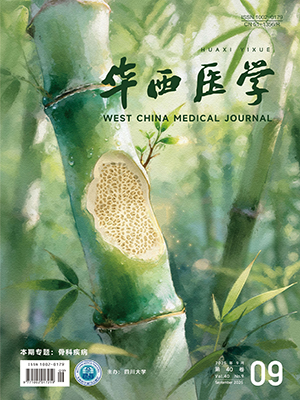摘要:目的:总结巨大垂体腺瘤水钠代谢紊乱的围手术期处理经验。方法:对71例巨大垂体腺瘤患者术前及术后1周内每日检测血、尿电解质水平,以及血、尿渗透压,判断失钠及失水类型。总结不同瘤体大小与手术入路和水钠紊乱发生率、程度、时间之间的关系。结果:71例巨大垂体腺瘤患者中,出现水钠代谢紊乱52例,发生率73.2%。肿瘤大小与水钠紊乱发生率、严重程度、发生时间成正比,而手术入路选择与水钠代谢紊乱发生无明显相关。结论:巨大垂体腺瘤患者术后水钠代谢紊乱的发生与瘤体大小成正相关,其出现时间和表现形式复杂。对水钠代谢紊乱严重患者可适当予以预防性治疗,以减少临床症状和不良后果。
Abstract: Objective: To summarize the preioperative management experience of metabolic disturbance of water and natrium for patients with giant pituitary adenomas. Methods: The electrolyte and osmotic pressure of blood and urine in patients with giant pituitary adenomas were detected within preoperative and postoperative one week and the type of the metabolic disturbance of water and natrium were determined. The correlation of the different tumor size and surgical approach with the incidence rate, extent and time of the metabolic disturbance was summarized. Results: There were 52 cases with different extent metabolic disturbance of water and natrium in 71 cases of giant pituitary adenomas(73.2%). There were a positive correlation of tumor size with the incidence rate, extent and time of the metabolic disturbance, and a negative correlation of surgical approach with that of the metabolic disturbance. Conclusion: The metabolic disturbance of water and natrium in giant pituitary adenomas was positive correlation with the tumor size, which. is various in emergence time and pattern of manifestation. To reduce the clinical symptoms and adverse consequences, prophylactic treatment may be used in patients with serious metabolic disorder of water and natrium.
Citation: HENG Kai,LUO Xiulin,JIANG Shu.. The Preioperative Management of Metabolic Disturbance of Water and Natrium for Patients with Giant Pituitary Adenomas. West China Medical Journal, 2009, 24(11): 2845-2847. doi: Copy
Copyright © the editorial department of West China Medical Journal of West China Medical Publisher. All rights reserved




